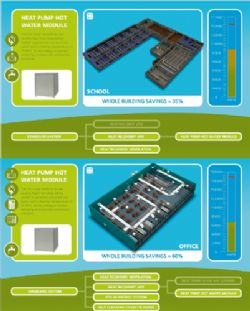Whether offices, shops, schools, civic buildings, hotel and leisure or healthcare facilities, the pressure to change the way we heat and cool buildings is increasing. John Durbin looks at how an integrated approach to climate control can result in dramatic energy and carbon savings - especially when heat recovery techniques are incorporated within a heat pump-based system
The Department for Energy and Climate Change's Pathways to 2050 report clarifies the changes to the way we heat and cool our buildings required to meet the Government's legally binding carbon reduction targets. It identifies that the built environment will have to reduce its emissions by around 45 per cent over the next few decades. As heating, cooling and refrigeration are some of the largest sources of energy consumption in buildings, it makes sense to look at how carbon emissions from these services can be reduced.
Because many commercial and public buildings typically operate quite separate systems for heating and cooling, as well as for hot water provision and refrigeration systems, a huge amount of energy is wasted. Take, for example, a health centre. Cooling may well be provided by a chilled-water based system, heating and hot water provision by a gas-boiler and refrigeration by another separate system. If the climate control needs of the entire building were examined as a whole, a large amount of waste heat generated from both the refrigeration and cooling systems could be collected and re-used for space or hot water heating, where it is needed.
Major carbon reductions From this example, it is easy to see that by taking a look at the whole building's heating and cooling needs and delivering an integrated climate control solution, it is possible to increase energy efficiency dramatically, thus achieving major reductions in carbon emissions and helping to reduce running costs.
One of the best ways, of course, to create this integrated solution is through Variable Refrigerant Volume (VRV) technology. This well-established heat pump technology has been developed into a total solution for heating, cooling, refrigeration and ventilation, capable of creating a 'virtuous circle' of climate control within a building - both for new build and for retrofit.
As is widely acknowledged, VRV's great advantage is that it varies the refrigerant volume within the system to match precisely the building's requirements at any moment. This allows each area to continually maintain its set temperature, while saving both money and carbon emissions, because it only uses the minimum level of energy required.

As a result, the efficiencies this heat pump-based technology delivers (typically outputs of three to five times the energy input required) remain among the highest currently being achieved in the industry.
By incorporating heat recovery, it is possible to increase these efficiencies even further. What's more, VRV based systems are ideally suited for retrofit, as they can be installed on a floor-byfloor basis, causing minimum disruption to a busy working environment.
So if we take the same health centre example, VRV ideal for those areas that require both heating and cooling, such as wards, reception and public areas, cafes and consulting rooms. In this way an area of the building that experiences the highest heat gains can be cooled by transferring this excess heat to other areas of the building that require heating or hot water provision. An example of this would be to use a heat recovery air curtain at the entrance to the building. In this way the excess heat produced by the cooling system could be used to supply heat to the air curtain or even to supply hot water to kitchens or showers. Field trials have shown that this type of heat recovery air curtain can make 67 per cent energy savings compared with a conventional air curtain.
VRV systems are also perfect for schools, leisure centres and many other buildings, each of which has many different areas with individual climate control needs.
Recapturing heat
Refrigeration systems also produce heat as a by-product of their cooling process. Again, by using a VRV-based refrigeration system we can recapture this heat and use it elsewhere. So the waste heat emitted by a cold-store in a school kitchen could be used to heat the kitchen's hot water supply.
By examining a building's climate control needs as a whole, it is possible to use heat recovery techniques to dramatically improve energy efficiency. This will result in fewer carbon emissions and reduced running costs - both of which are of major importance to improve energy performance in the built environment.
// The author is engineering department manager at Daikin UK //